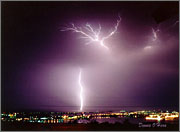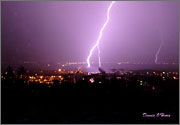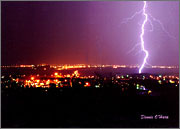With a few basic tips, your  lightning pictures can be some of the
lightning pictures can be some of the most spectacular images in your portfolio.
most spectacular images in your portfolio.
The first lesson in lightning  photography is to realize to power
photography is to realize to power  in a lightning storm and never
in a lightning storm and never  to take a chance with safety.
to take a chance with safety.  Always make sure you are
Always make sure you are  photographing from an observation
photographing from an observation  point that will not be in the
point that will not be in the  path of the approaching storm.
path of the approaching storm.
When you have selected a  location that will offer the widest
location that will offer the widest  sky panorama set up your camera on
sky panorama set up your camera on  a tripod and use a cable release
a tripod and use a cable release  to ensure a stable platform
to ensure a stable platform  for your camera as your
for your camera as your  shutter could be open for up
shutter could be open for up  to several minutes.
to several minutes.
The most optimum time  for shooting is when the sky is completely
for shooting is when the sky is completely  dark so that exposure times
dark so that exposure times  can be long.
can be long.
Set you camera shutter speed  to the "bulb" setting or the longest
to the "bulb" setting or the longest  exposure time possible. Using a lens
exposure time possible. Using a lens  wide enough to view the entire horizon,
wide enough to view the entire horizon, set the F-Stop to 5.6 and use a film speed
set the F-Stop to 5.6 and use a film speed  of 100 ASA, this will extend the
of 100 ASA, this will extend the  shutter open time. The intensity of
shutter open time. The intensity of  the lightning should easily
the lightning should easily  expose the film.
expose the film.
Once the storm approaches, estimate  the time between strikes
the time between strikes  and hold the shutter open for
and hold the shutter open for  several good strokes or until you
several good strokes or until you  excede 2-3 minutes, depending on
excede 2-3 minutes, depending on  ambient light conditions. It often
ambient light conditions. It often  works well to have either city
works well to have either city  light in the distance or an object
light in the distance or an object  in the foreground for a reference.
in the foreground for a reference.
With a few nights of practice  from a safe location, you will be able to
from a safe location, you will be able to  shoot great lightning images.
shoot great lightning images.

 O'Hara
O'Hara lightning pictures can be some of the
lightning pictures can be some of the most spectacular images in your portfolio.
most spectacular images in your portfolio.

